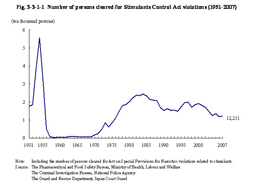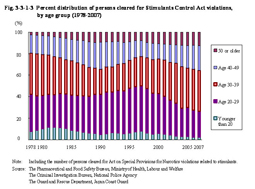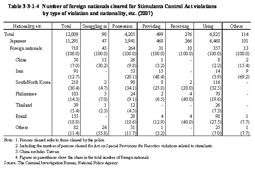| Previous Next Index Image Index Year Selection | |
|
|
1 Stimulants Control Act violations Stimulants abuse began to become widespread during the chaotic postwar period, however, persons cleared fell sharply after a peak over 50,000 in 1954. As a background, it has been pointed out that penal regulations were tightened, that clearance by police was implemented thoroughly, and that educational campaigns concerning the harmful influence of stimulants were held nationally. However, the number of persons cleared took an upward turn again in 1970 and reached 24,372 in 1984, recording the second peak. After that, the number fell below 20,000 in 1989 and had leveled off until 1994. It started to increase again in 1995 and reached almost 20,000 in 1996, 1997, and 2000. After that, it has generally been on a decreasing trend, but increased slightly in 2007. Fig. 3-3-1-1 Number of persons cleared for Stimulants Control Act violations (1951–2007) Table 3-3-1-2 shows the number of persons cleared for Stimulants Control Act violations (only those cleared by the police) over the last five years by type of violation, as well as the number of those who violated the act for profit. The ratio of persons cleared for non-profit possession and use to total number of persons cleared in 2007 was 88.9%, and the majority of those were general stimulant abusers.Table 3-3-1-2 Number of persons cleared for Stimulants Control Act violations by type of violation (2003–2007) Fig. 3-3-1-3 shows the percent distribution of persons cleared for Stimulants Control Act violations over the last 30 years by age group. The percent ratio of those aged 30–39 was the highest from 1978 to 1984, while that of those aged 20–29 was the highest since 1985. However, the proportion of those aged 30–39 was the highest again since 2002.Fig. 3-3-1-3 Percent distribution of persons cleared for Stimulants Control Act violations, by age group (1978–2007) Table 3-3-1-4 shows the number of persons cleared (only those cleared by the police) for Stimulants Control Act violations in 2007, by type of violation and nationality, etc.Table 3-3-1-4 Number of foreign nationals cleared for Stimulants Control Act violations by type of violation and nationality, etc. (2007) Table 3-3-1-5 shows the number of Boryokudan members, etc. among those cleared for Stimulants Control Act violations (only those cleared by the police) over the last five years, by type of violation.The percent ratio of Boryokudan members, etc. to total persons cleared has been on the rise since 2003, exceeded 50% in 2005, and reached 53.0% in 2007. Table 3-3-1-5 Number of Boryokudan members, etc. in the persons cleared for Stimulants Control Act violations by type of violation (2003–2007) |




